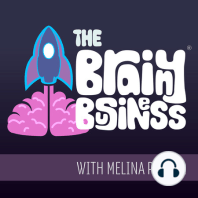33 min listen

33. Inside the Texas A&M Human Behavior Lab
FromThe Brainy Business | Understanding the Psychology of Why People Buy | Behavioral Economics
33. Inside the Texas A&M Human Behavior Lab
FromThe Brainy Business | Understanding the Psychology of Why People Buy | Behavioral Economics
ratings:
Length:
36 minutes
Released:
Feb 1, 2019
Format:
Podcast episode
Description
I recently took a trip down to College Station, Texas to visit the Human Behavior Lab at Texas A&M University – which is (at the time of recording) the largest human behavior lab in the world. Today’s behavioral economics podcast gives you an inside look at what happens inside of a laboratory like this. In this episode, I interview Dr. Marco Palma to find out what really goes on and answer questions like how do they actually take these concepts from behavioral economics and study them to impact real businesses? What sort of equipment do they use? How do they know what is going on in the brain and more. I hope you enjoy this sneak peek into what really goes on behind the scenes at a Human Behavior Lab. Show Notes [04:11] The lab has sensors that helps them understand human behavior and what drives the emotions. [04:34] We are heavily influenced by our emotions, and in some cases, don't even realize it. [04:59] Some of the equipment they use includes facial expression readers which can correlate movements in the face with emotions. [05:19] They also have the capability of looking directly into your brain. They can measure stress signals like respiration and heart rates. [05:38] They are trying to understand and measure the motivations behind behavioral economics. [06:03] They also want to test results in the real world. [06:15] The virtual room is a mock grocery store which allows for testing with real products. [07:00] Experiments are conducted in a controlled laboratory environment and in the real world to understand the complexities. [07:27] They use eye-tracking hardware created by Tobii. They can also combine this with an EEG device and have all the hardware in a very small backpack so the subject is mobile. [08:18] The global leader that makes it easy to synchronize multiple devices at the same time is iMotions. [09:19] These new tools have really advanced the pace of discoveries that they can make. [10:02] They're interested in emulating what drives attention. When they know what people are paying attention to the message can be created in a way that will be noticed. [11:18] This is also useful for judging the effectiveness of a website and product placement in a store or display. [11:54] Everything matters. Often small things that we don't think will matter can make a huge impact. [13:15] We are often guilty of making messages that are overly complex. We want the message to be perceived as simply as possible and to clearly communicate the benefits. [13:56] Menu optimization includes maximizing benefits and minimizing cost. Anchoring can be used for pricing on menus. Work done with eye tracking shows how people actually search for information. These clues can tell you where to place your anchors. [16:16] We use rapid eye movements and digest a lot of information in a very fast manner. [18:00] These devices can track 600 data points per second. Collecting data allows us to make inferences about behavior. [20:15] The foundation of what they do in the lab comes back to establishing causality. [21:52] They control for every detail to establish causality. [22:25] In 2019, they are interested in looking at self control. [22:52] By February 1st, 80% of Americans will have given up on their goals. [23:22] Small changes are much more sustainable than large drastic changes. [23:57] They are also going to look at cheating and lying. They are looking at what drives people to cheat for themselves and for other people. [24:41] What drives the behavior based on the assumption that large corporations or the government aren't being hurt by cheating? [24:52] They are also going to look at what drives people to be more generous. They're going to look at drivers for giving. Also at things like matching funds and fundraising campaigns. [26:15] They are also looking into competition and what drives high-achieving individuals. [27:23] They are trying to find ways to promote competition particularly for women. [29:12] Dr. Palma also wants to
Released:
Feb 1, 2019
Format:
Podcast episode
Titles in the series (100)
14. Scarcity: Why We Think Less Available Means More Value: Fall is a favorite season of mine and probably a favorite season to many of you. It’s also the time of year that my favorite honeycrisp apples are available. Like cotton candy grapes, these apples benefit from scarcity. Today, I break down what... by The Brainy Business | Understanding the Psychology of Why People Buy | Behavioral Economics